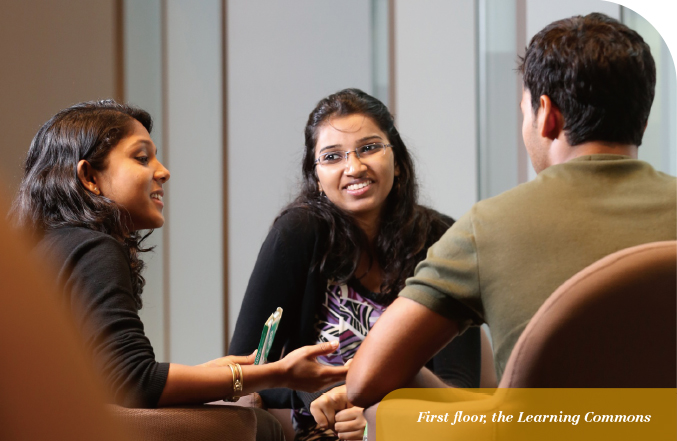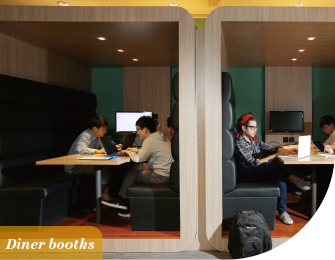

|
|||
|
"It's a huge difference to what we had before and it's really nice. Before we could study in the library and it was all small cubicles. Now it's open and easy to communicate."
- Keerthana Raghavan (pictured centre), Bachelor of Engineering Year 3
|
|||
New Learning Environments Curriculum reform at HKU is not only about the content, it is also about the context. The new campus is an impressive showcase for our goals in student learning. It translates flexibility and student-led learning into a physical form that is modern and stimulating and extends the learning environment beyond the traditional classroom (which is undergoing change, too). The centrepiece of the new campus is the Chi Wah Learning Commons, a unique facility with high ceilings, big windows, bright colours and a large choice of learning spaces – but no books. The Main Library remains the facility for that. Instead, the Learning Commons recognises that students have different learning needs at different times. They need quiet areas for contemplation, private rooms for focused work on group projects, open areas where they can meet with classmates for casual discussion, access to technology-enabled facilities, and a variety of surfaces and levels for reading, paperwork, computer work and other activities. |
|||
|
The Learning Commons provides all these things in 6,000 square metres over two floors. It has been likened to an academic airport lounge. There are tables with chairs on wheels, private study rooms, diner booths, beanbags, sofas with low tables, bar chairs next to high worktop ledges and quiet rooms. All of these come in a variety of formats – for example, there are four different kinds of diner booths – and colours. The large degree of flexibility supports the goal of putting students in charge of their learning. Classrooms are located along the edges of the Learning Commons so that students can go straight from class to a space for individual study or group work. Teachers can also use the private study rooms for individual tutorials. Furthermore, the classrooms themselves are designed to break down the rigid structures of traditional learning. Chairs are on wheels so students can be configured into groups, pairs, a circle, a horseshoe, traditional rows – anything that best suits that particular lesson. There are whiteboards that can be used by both students and teachers. About 70 such classrooms are being used by the faculties housed in the new campus. |

"The wood in the booth is lovely – I like the modern zebra wood feel to it. The booth is like my home or little corner away from things. It gives you a coffee-shop feel."
- Michael Lipp (pictured right), Year 4 Business exchange student from the University of California, Davis
|
||
In addition, there are eight innovative, technology-enabled classrooms where teachers have an opportunity to be inventive in their pedagogy. The rooms come in a variety of sizes, with capacities ranging from about 25 to 100 or more students, and they have a variety of furniture. Some have fixed tables, others specially-designed 'wedge' tables that can fit together in any configuration that works best for a particular lesson. LCD screens are mounted around the rooms so small groups of students each get their own screen; the screens can also all be connected to a single computer so students and the teacher can share work. A mimeo whiteboard enables teachers to save notes written on the board in a computer file that can later be accessed by students. It is hoped teachers and students will find new ways of making use of these resources to enhance learning. A final important feature of the new campus is that it extends learning spaces beyond the Learning Commons and classrooms. Tables alongside 'University Street', which links the old and new campuses, have power plugs nearby so students can sit in the open air to work. The new campus courtyard, a grass lawn atop the moot court and the music library roof garden also give students options for studying – and relaxing – beyond the classrooms, libraries and canteens. |
|||